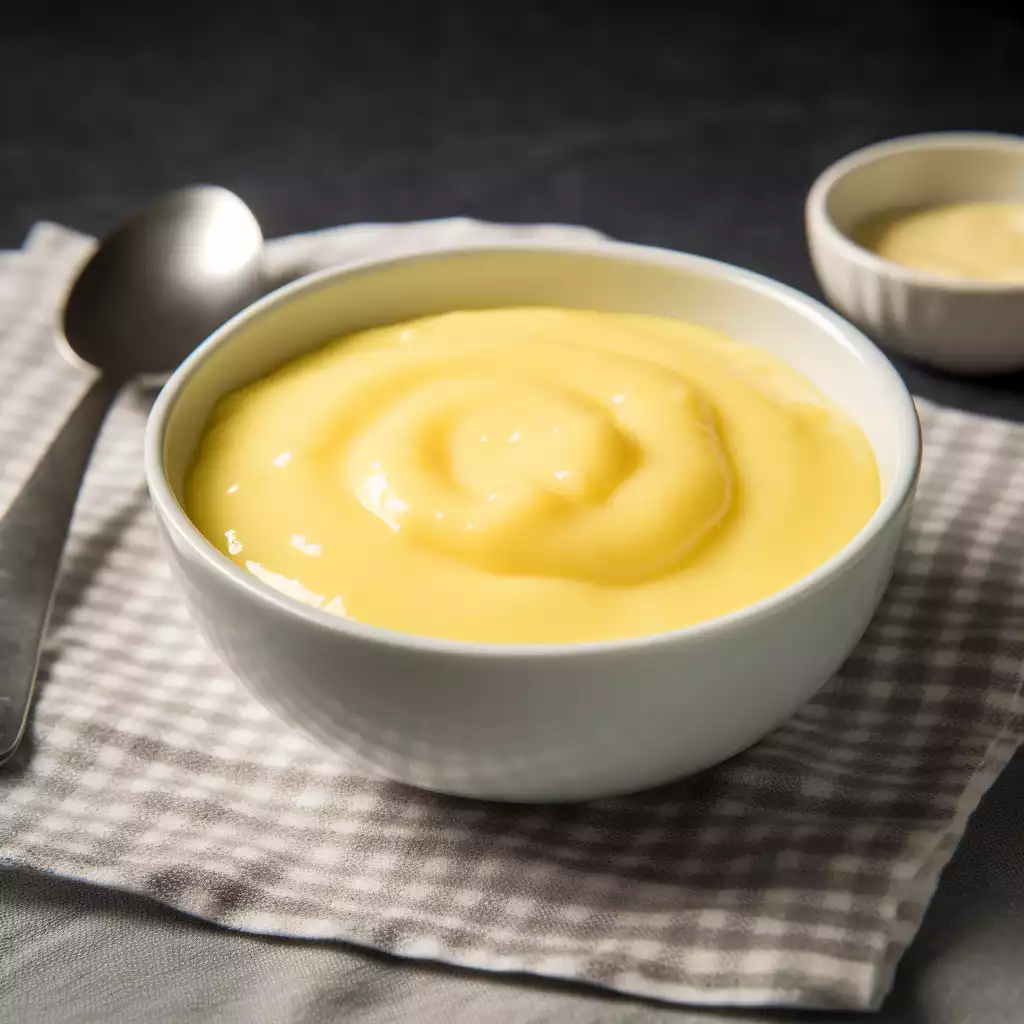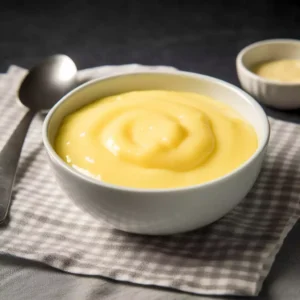
Vanilla custard holds a special place in the hearts of dessert lovers everywhere. Known for its rich flavour and creamy texture, this classic dish has been a staple in kitchens for generations.
The origins of custard are believed to date back to the Middle Ages, primarily used in sweet and savoury pie fillings. However, it was the addition of vanilla, a flavour that became popular in Europe in the 1600s, that truly transformed it into the dessert we know and love today.
Making vanilla custard might seem daunting at first, but it’s surprisingly straightforward. It’s a fantastic recipe for beginners, primarily because it teaches the importance of temperature control and the art of patience.
The key to perfect custard lies in the gentle heating and constant stirring, ensuring a smooth, lump-free texture.
There are numerous variations of vanilla custard, each bringing its own unique twist to this classic recipe. Some prefer to infuse the milk with a vanilla pod for a more intense flavour, while others might add a dash of cinnamon or nutmeg for a spicy note.
In France, custard is often thickened with flour to make Crème Pâtissière, a staple in pastries like éclairs and fruit tarts.
In contrast, in the UK, it’s enjoyed as a pourable sauce, often served warm over puddings and pies.
Vanilla custard’s versatility extends beyond these regional differences. It’s the base for many other desserts like ice cream, trifles, and even some types of cake fillings. This adaptability makes it an essential recipe to master for anyone who loves to experiment in the kitchen.
When making vanilla custard, it’s crucial to use high-quality ingredients. Fresh, whole milk and real vanilla extract can make a significant difference in the end product.
The choice of vanilla is particularly important; using pure extract or a vanilla bean pod can elevate the flavour from simple to sophisticated.
The beauty of vanilla custard lies not just in its deliciousness but also in its simplicity.
With just a few ingredients – milk, sugar, egg yolks, cornflour, and vanilla – you can create a dessert that’s both comforting and elegant. It’s a testament to the magic that can happen in the kitchen when a few basic components come together under the right conditions.
As you embark on making this delightful dessert, remember that patience is key.
The process of stirring the mixture over low heat might seem tedious, but it’s what ensures that your custard achieves the perfect consistency. It’s a lesson in the art of slow cooking, where taking your time yields the most rewarding results.
Vanilla custard is more than just a dessert. It’s a journey through history, a lesson in culinary basics, and a canvas for creativity.
Whether you’re a beginner or an experienced cook, making vanilla custard from scratch is a rewarding experience that’s sure to impress.
Expert Tip: For a richer flavour, replace some of the milk with cream. This adds extra creaminess and depth to the custard, perfect for those special occasions or when you want a more indulgent dessert.
Whole Milk: Whole milk is ideal for vanilla custard due to its rich fat content, which contributes to the custard’s creamy texture.
The fats in whole milk also help in stabilising the mixture, ensuring a smooth consistency. If you’re looking for an alternative, semi-skimmed milk can be used, though the custard may be less creamy.
Caster Sugar: The fine granules of caster sugar dissolve easily, ensuring a smooth texture in the custard. Caster sugar sweetens the custard without overpowering the vanilla flavour. If unavailable, granulated sugar can be used, but it should be dissolved thoroughly to avoid a grainy texture.
Egg Yolks: Egg yolks are crucial for thickening the custard, giving it a luxurious, velvety texture. They also add a subtle richness in flavour. For those who can’t consume eggs, a mixture of cornflour and plant-based milk can be an alternative, but this will change the texture and taste significantly.
Cornflour: Cornflour acts as a thickening agent in the custard. It helps in achieving the desired consistency without altering the flavour. If cornflour is not available, potato starch or even finely ground rice flour can be used as substitutes, though they may slightly alter the texture.
Vanilla Extract: Vanilla extract adds the characteristic flavour that is central to this dish. It brings a warm, aromatic quality to the custard. If you want to experiment, vanilla bean paste or a vanilla pod can be used for a more intense vanilla flavour.
Each of these ingredients plays a unique role in creating the perfect vanilla custard. The milk and egg yolks form the base, the sugar adds sweetness, cornflour provides thickness, and vanilla extract offers the essential flavour.
By understanding the role of each component, you can confidently experiment and even make substitutions as needed.
Expert Tip: Don’t rush the cooking process. Low and slow is the way to go with custard. Cooking it on a gentle heat prevents curdling and ensures a smooth, velvety texture. Patience really pays off here.
Yes, you can make egg-free vanilla custard, though the texture and taste will be different. Typically, a combination of cornflour and plant-based milk can be used as a substitute. The cornflour acts as a thickener, while the plant-based milk adds creaminess. However, expect a lighter texture and a slightly different flavour profile compared to traditional egg-based custard.
Curdling often occurs when the eggs are heated too quickly. To prevent this, heat the milk gently and add it slowly to the egg mixture, whisking continuously. This process, called tempering, gradually increases the temperature of the eggs without cooking them. Also, constantly stir the custard while cooking it on low heat to ensure even heat distribution.
Absolutely, vanilla custard can be made a day or two in advance. Once cooled, cover it with cling film, pressing the film directly onto the surface of the custard to prevent a skin from forming. Store it in the refrigerator until you’re ready to use it. Before serving, give it a good stir to bring back its smooth texture.
If your custard is too runny, it’s likely it hasn’t been cooked long enough. Return it to low heat and cook, stirring constantly, until it thickens. If it remains runny, a little more cornflour mixed with cold milk can be added. Add this mixture gradually, and cook for a few more minutes to achieve the desired consistency.
Leftover vanilla custard can be a delightful ingredient in other desserts. You can use it as a filling for cakes or pastries, serve it alongside fruit, or even add it to a trifle. It can also be frozen and later used as a base for homemade ice cream.
Another creative way to use it is in a custard tart or as a layer in a dessert parfait. The versatility of vanilla custard means the possibilities for using leftovers are almost endless, allowing you to be imaginative in the kitchen.
Expert Tip: Experiment with vanilla types. Using a vanilla bean pod instead of extract can give a more pronounced vanilla flavour. Scraping the seeds from the pod into the milk infuses the custard with tiny, flavour-packed specks of vanilla.
Here are some more recipes for you to enjoy! If you my recipes don’t forget to rate and leave a comment.
If you have any recipe suggestions, please do not hesitate to ask me. A great way to stay in contact with me is through Instagram, Facebook, Twitter and YouTube. Don’t forget to tag me @CookwithNabeela in your recipe photos!

Subscribe now to receive my latest recipes directly in your inbox. Stay up-to-date and never miss out!

I love to cook! I want to share with you my favourite, delicious family-friendly recipes. I want to inspire you to create fantastic food for your family every day.
Add your first comment to this post